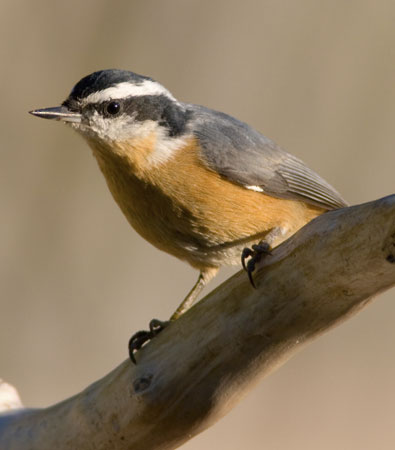Sitta canadensis
If you hear what sounds like a child?s tin horn, a soft, thin, high-pitched “Ank…ank…ank” outside the window, expect to see a Red-breasted Nuthatch! Our most colorful nuthatch, Red-breasts can be heard year-round across much of Canada and south into the Rocky and Appalachian mountains of the United States. If they are present, conifer trees (spruce, pine, hemlock, fir, larch) are likely nearby. In years when their evergreens fail to produce sufficient seeds, they will migrate into other parts of the country. These movements are highly variable and the Red-breasted Nuthatch has been recorded in some far-flung places.
Once you have spotted a Red-breasted Nuthatch, there is so much to take in: a lovely rufous breast, a handsome blue-grey back, a bold black eye line bordered by white. The distinction between male and female is subtle; the top of her head is a dark grey while his is black. The male’s eye-stripe is also broader. This nuthatch is smaller than the more common White-breasted Nuthatch.
Conifer seeds are the obvious food choice. During nesting season the diet shifts to insects. These nuthatches are common visitors to bird feeders within their year-round range, and treat backyard hobbyists to their presence at feeders when they make periodic winter visits outside their normal range. Offering a food like Aspen Song® Chickadee Mix full of peanuts, nutmeats, and sunflowers is a sure way to entertain these delightful visitors.
Red-breasted Nuthatches often will cache these seeds, storing them for future consumption. A favorite foraging site is the trunks and large boughs of trees where they easily climb up and down the trunk, probing with their bill for morsels. One recent and fascinating study concluded these nuthatches seem to “sort and weigh” feeder offerings, and will opt for the heavier seeds.
Nuthatches are cavity nesters. White-breasted Nuthatches locate an existing natural cavity or take up residence in abandoned woodpecker holes. Red-breasted Nuthatches excavate their own cavities. They will utilize a dead or decaying tree with soft wood fibers. The female seems to be responsible for choosing the neighborhood, both start the homebuilding, and the female does most of the “heavy lifting” while the male brings her food and guards the location. For our hard-working couple, “a house is not a home” until they have applied conifer resin to the entrance. The pair will collect the sticky resin and apply it with either their bill or use pieces of bark as “paint brushes.”
Altogether, a beautiful bird with a fascinating story!
Reference
Ghalambor, Cameron K. and Thomas E. Martin. 1999. Red-breasted Nuthatch (Sitta canadensis), The Birds of North America Online (A. Poole, Ed.). Ithaca: Cornell Lab of Ornithology.

